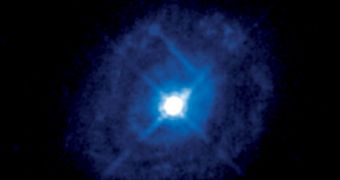Several spacecraft belonging to the European Space Agency (ESA) were recently involved in an international effort to scrutinize the outskirts of a black hole as close to the event horizon as possible. The vessels discovered that the dark behemoth shoots out bullet-shaped clouds of hydrogen gas.
With all of its gravitational pull, the black hole is apparently capable of driving things away from its hungry mouth as well. The discovery left astrophysicists puzzled and scrambling to solve the mystery.
The new study is also remarkable because it produced the most detailed view of a black hole's surroundings. No other collaboration of observatories was able to get so close to the actual object without losing their capabilities.
In all fairness, the effort had some pretty impressive satellites at its disposal, including XMM-Newton (X-ray Multi-Mirror Mission – Newton) and INTEGRAL ( INTErnational Gamma-Ray Astrophysics Laboratory). Their combined capabilities are indeed amazing.
The science group focused its instruments on the active galactic nucleus (AGN) Markarian 509, an object that is powered by a supermassive black hole at its core. It lies about 500 million light-years away from Earth. For comparison, the Milky Way is about 120,000 light-years across.
The black hole at its core is about 300 million times more massive than the Sun, and continues to grow as it accretes new mass every day. The reason why the team selected this object is because the AGN exhibits displays in brightness.
Astronomers interpret this variability as indicating that the flow of matter through the black hole's accretion disk, and into its event horizon, is turbulent. The cause for this turbulence, the team established, is the large number of gas bullets being thrown away from near the black hole.
“XMM-Newton really led these observations because it has such a wide X-ray coverage, as well as an optical monitoring camera,” SRON Netherlands Institute for Space Research expert and team coordinator Jelle Kaastra says.
The research group featured 26 astronomers from 21 research institutions and universities across 4 continents. It determined that the gas clouds were being ejected from around the black holes of speeds of millions of kilometers per hour.
The NASA/ESA Hubble Space Telescope, the NASA Chandra X-ray Observatory and the Swift satellites were also used in this investigation, as were the WHT and PARITEL ground-based telescopes. Coverage capabilities ran from infrared through X-rays and gamma-rays.
“The results underline how important long-term observations and monitoring campaigns are to gain a deeper understanding of variable astrophysical objects. XMM-Newton made all the necessary organisational changes to enable such observations, and now the effort is paying off,”ESA XMM-Newton project scientist Norbert Schartel explains.

 14 DAY TRIAL //
14 DAY TRIAL //